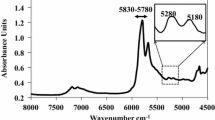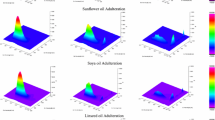Abstract
This research investigates the use of excitation-emission matrix fluorescence (EEMF) in conjunction with chemometric models to rapidly identify and quantify adulteration in olive oil, a critical concern where sample availability is limited. Adulteration is simulated by blending soybean, peanut, and linseed oils into olive oil, creating diverse adulterated samples. Principal component analysis (PCA) was applied to the EEMF spectral data as an initial exploratory measure to cluster and differentiate adulterated samples. Spatial clustering enabled vivid visualization of the variations and trends in the spectra. The novel application of parallel factor analysis (PARAFAC) for data decomposition in this paper focuses on unraveling correlations between the decomposed components and the actual adulterated components, which offers a novel perspective for accurately quantifying adulteration levels. Additionally, a comparative analysis was conducted between the PCA and PARAFAC methodologies. Our study not only unveils a new avenue for the quantitative analysis of adulterants in olive oil through spectral detection but also highlights the potential for applying these insights in practical, real-world scenarios, thereby enhancing detection capabilities for various edible oil samples. This promises to improve the detection of adulteration across a range of edible oil samples, offering significant contributions to food safety and quality assurance.







Similar content being viewed by others
Data Availability
This manuscript has no associated data.
Code Availability
Not applicable.
References
Zhang T, Liu YY, Dai ZP et al (2022) Quantitative Detection of Extra Virgin Olive Oil Adulteration, as opposed to peanut and Soybean Oil, employing LED-Induced fluorescence spectroscopy. Sensors 22:1227–1235. https://doi.org/10.3390/s22031227
Hamdy O, Mohammed HS (2023) Post-heating fluorescence-based Alteration and Adulteration Detection of Extra Virgin Olive Oil. J Fluoresc 33:1631–1639. https://doi.org/10.1007/s10895-023-03165-8
Troya F, Lerma-García MJ, Herrero-Martínez JM et al (2015) Classification of vegetable oils according to their botanical origin using n-alkane profiles established by GC–MS. Food Chem 167:36–39. https://doi.org/10.1016/j.foodchem.2014.06.116
Salghi R, Armbruster W, Schwack W (2014) Detection of argan oil adulteration with vegetable oils by high-performance liquid chromatography–evaporative light scattering detection. Food Chem 153:387–392. https://doi.org/10.1016/j.foodchem.2013.12.084
Ozcan-Sinir G (2020) Detection of adulteration in extra virgin olive oil by selected ion flow tube mass spectrometry (SIFT-MS) and chemometrics. Food Control 118:107433. https://doi.org/10.1016/j.foodcont.2020.107433
Huang Z-M, **n J-X, Sun S-S et al (2021) Rapid Identification of Adulteration in Edible Vegetable oils based on low-Field Nuclear magnetic resonance relaxation fingerprints. Foods 10:3068. https://doi.org/10.3390/foods10123068
De Lima TK, Musso M, Bertoldo Menezes D (2020) Using Raman spectroscopy and an exponential equation approach to detect adulteration of olive oil with rapeseed and corn oil. Food Chem 333:127454. https://doi.org/10.1016/j.foodchem.2020.127454
Mcreynolds N, Auñón Garcia JM, Guengerich Z et al (2016) Optical spectroscopic analysis for the discrimination of Extra-virgin Olive Oil. Appl Spectrosc 70:1872–1882. https://doi.org/10.1177/0003702816645931
Varnasseri M, Muhamadali H, Xu Y et al (2021) Portable through Bottle SORS for the Authentication of Extra Virgin Olive Oil. Appl Sci 11:8347. https://doi.org/10.3390/app11188347
Feng Y-Z, Elmasry G, Sun D-W et al (2013) Near-infrared hyperspectral imaging and partial least squares regression for rapid and reagentless determination of Enterobacteriaceae on chicken fillets. Food Chem 138:1829–1836. https://doi.org/10.1016/j.foodchem.2012.11.040
Vasconcelos M, Coelho L, Barros A et al (2015) Study of adulteration of extra virgin olive oil with peanut oil using FTIR spectroscopy and chemometrics. Cogent Food Agric 1:1018695. https://doi.org/10.1080/23311932.2015.1018695
Abdel-Salam Z, Abdel-Salam SM, Harith MA (2017) Application of laser Spectrochemical Analytical techniques to follow up spoilage of White Meat in Chicken. Food Anal Method 10:2365–2372. https://doi.org/10.1007/s12161-017-0806-5
Sezer B, Bjelak A, Murat Velioglu H et al (2022) Identification of meat species in processed meat products by using protein based laser induced breakdown spectroscopy assay. Food Chem 372:131245. https://doi.org/10.1016/j.foodchem.2021.131245
Mu T, Chen S, Zhang Y et al (2015) Portable Detection and Quantification of Olive Oil Adulteration by 473-nm laser-Induced fluorescence. Food Anal Method 9:275–279. https://doi.org/10.1007/s12161-015-0199-2
Vanstone N, Moore A, Martos P et al (2018) Detection of the adulteration of extra virgin olive oil by near-infrared spectroscopy and chemometric techniques. Food Qual Saf-Oxford 2:189–198. https://doi.org/10.1093/fqsafe/fyy018
Gyftokostas N, Stefas D, Kokkinos V et al (2021) Laser-induced breakdown spectroscopy coupled with machine learning as a tool for olive oil authenticity and geographic discrimination. Sci Rep 11:5360. https://doi.org/10.1038/s41598-021-84941-z
Mbogning Feudjio W, Mbesse Kongbonga GY, Kogniwali-Gredibert SBC et al (2021) Characterization of engine lubricants by fluorescence spectroscopy and chemometrics. Spectrochimi Acta A 252:119539. https://doi.org/10.1016/j.saa.2021.119539
Li M-X, Li Y-Z, Chen Y et al (2021) Excitation-emission matrix fluorescence spectroscopy combined with chemometrics methods for rapid identification and quantification of adulteration in Atractylodes Macrocephala Koidz. Microchem J 171:106884. https://doi.org/10.1016/j.microc.2021.106884
Durán Merás I, Domínguez Manzano J, Airado Rodríguez D et al (2018) Detection and quantification of extra virgin olive oil adulteration by means of autofluorescence excitation-emission profiles combined with multi-way classification. Talanta 178:751–762. https://doi.org/10.1016/j.talanta.2017.09.095
Ali H, Saleem M, Anser MR et al (2018) Validation of Fluorescence Spectroscopy to Detect Adulteration of Edible Oil in Extra Virgin Olive Oil (EVOO) by applying Chemometrics. Appl Spectrosc 72:1371–1379. https://doi.org/10.1177/0003702818768485
Mazivila SJ, Soares JX, Santos JLM (2022) A tutorial on multi-way data processing of excitation-emission fluorescence matrices acquired from semiconductor quantum dots sensing platforms. Anal Chim Acta 1211:339216. https://doi.org/10.1016/j.aca.2021.339216
Murphy KR, Stedmon CA, Graeber D et al (2013) Fluorescence spectroscopy and multi-way techniques. PARAFAC Anal Method 5:6557–6566. https://doi.org/10.1039/C3AY41160E
Wang T, Wu H-L, Long W-J et al (2019) Rapid identification and quantification of cheaper vegetable oil adulteration in camellia oil by using excitation-emission matrix fluorescence spectroscopy combined with chemometrics. Food Chem 293:348–357. https://doi.org/10.1016/j.foodchem.2019.04.109
Camara ABF, Da Silva WJO, Neves ACO et al (2024) Excitation-emission fluorescence spectroscopy coupled with PARAFAC and MCR-ALS with area correlation for investigation of jet fuel contamination. Talanta 266:125126. https://doi.org/10.1016/j.talanta.2023.125126
Lenhardt L, Bro R, Zekovic I et al (2015) Fluorescence spectroscopy coupled with PARAFAC and PLS DA for characterization and classification of honey. Food Chem 175:284–291. https://doi.org/10.1016/j.foodchem.2014.11.162
Guimet F, Boqué R, Ferré J (2006) Application of non-negative matrix factorization combined with Fisher’s linear discriminant analysis for classification of olive oil excitation–emission fluorescence spectra. Chemometr Intell Lab 81:94–106. https://doi.org/10.1016/j.chemolab.2005.10.003
Squeo G, Caponio F, Paradiso VM et al (2019) Evaluation of total phenolic content in virgin olive oil using fluorescence excitation-emission spectroscopy coupled with chemometrics. J Sci Food Agric 99:2513–2520. https://doi.org/10.1002/jsfa.9461
Xu R-Z, Cao J-S, Feng G et al (2022) Fast identification of fluorescent components in three-dimensional excitation-emission matrix fluorescence spectra via deep learning. Chem Eng J 430:132893. https://doi.org/10.1016/j.cej.2021.132893
Gu H, Liu K, Huang X et al (2020) Feasibility study for the analysis of coconut water using fluorescence spectroscopy coupled with PARAFAC and SVM methods. Brit Food J 122:3203–3212. https://doi.org/10.1108/bfj-12-2019-0941
Alostaz MD, Biggar K, Donahue R et al (2008) Petroleum contamination characterization and quantification using fluorescence emission-excitation matrices (EEMs) and parallel factor analysis (PARAFAC). J Environ Eng Sci 7:183–197. https://doi.org/10.1139/s07-049
Mazivila SJ, Olivieri AC (2018) Chemometrics coupled to vibrational spectroscopy and spectroscopic imaging for the analysis of solid-phase pharmaceutical products: a brief review on non-destructive analytical methods. TrAC. Trends Anal Chem 108:74–87. https://doi.org/10.1016/j.trac.2018.08.013
Kumar N, Bansal A, Sarma GS et al (2014) Chemometrics tools used in analytical chemistry: an overview. Talanta 123:186–199. https://doi.org/10.1016/j.talanta.2014.02.003
Bro R (1997) PARAFAC. Tutorial and applications. Chemometr Intell Lab 38:149–171. https://doi.org/10.1016/s0169-7439(97)00032-4
Stedmon CA, Bro R (2008) Characterizing dissolved organic matter fluorescence with parallel factor analysis: a tutorial. Limnol Oceanogr-Meth 6:572–579. https://doi.org/10.4319/lom.2008.6.572
Funding
This work was supported by the National Natural Science Foundation of China under grants 61805178; the Shandong Provincial Natural Science Foundation under grants ZR2018PF016 and ZR2019MD011.
Author information
Authors and Affiliations
Contributions
All authors contributed to the study conception and design. Z.L., C.N. and L.S. performed material preparation and data collection. H.X. and G.J. (Gao Juanjuan) performed the data analysis. G.J. (Gao **) prepared Figs. 1 and 2 and F.X. prepared Figs. 3 and 4, and Z.L. prepared Figs. 5, 6 and 7. Z.L. and C.N. wrote the first draft of the manuscript. W.Y. and W.C. reviewed and edited the manuscript. All authors commented on previous versions of the manuscript. All authors read and approved the final manuscript.
Corresponding authors
Ethics declarations
Ethical Approval
No ethical approval is required for this study.
Consent to Participate
Not applicable.
Consent for publication
All authors have read and approved the final manuscript.
Conflict of interest
The authors declare that they have no conflict of interest.
Additional information
Publisher’s Note
Springer Nature remains neutral with regard to jurisdictional claims in published maps and institutional affiliations.
Rights and permissions
Springer Nature or its licensor (e.g. a society or other partner) holds exclusive rights to this article under a publishing agreement with the author(s) or other rightsholder(s); author self-archiving of the accepted manuscript version of this article is solely governed by the terms of such publishing agreement and applicable law.
About this article
Cite this article
Lujun, Z., Nuo, C., **aodong, H. et al. Adulteration Detection and Quantification in Olive Oil Using Excitation-Emission Matrix Fluorescence Spectroscopy and Chemometrics. J Fluoresc (2024). https://doi.org/10.1007/s10895-024-03613-z
Received:
Accepted:
Published:
DOI: https://doi.org/10.1007/s10895-024-03613-z




